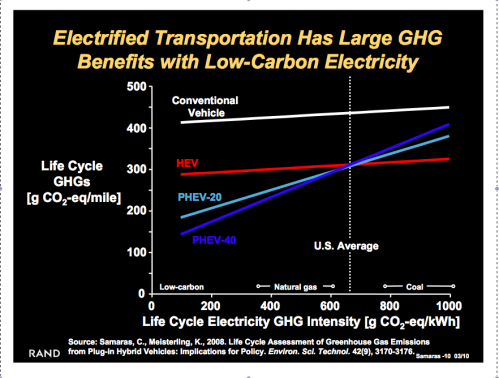
Earth Protect Blog
- Font size: Larger Smaller
- Hits: 3560
- 0 Comments
Electric Cars, Carbon-dioxide Emissions and Air Conditioning
Contrary to some of the recent rumors, at a base price of $32,780 it is relatively affordable… so affordable, in fact, that, after the $7,500 federal tax credit, Nissan is able to offer the LEAF for a lease price of $349 a month not including generous state incentives. When you add in some of those — like a $5,000 tax credit in California, up to $6,000 in Colorado, $5,000 in Georgia, and $1,500 in Oregon — all of a sudden you might be talking a final price of around $20K. [emphasis added.]
If that assessment by Gas 2.0 is correct, then the Leaf will be less expensive than the Toyota Prius. And, if this combination of incentives and pricing strategy holds for other companies including GM’s Chevy Volt, then we could see a serious, industry-wide rollout of electric vehicles over the next several years. This would be in stark contrast to the half-hearted and sporadic attempts of the past.
Adoption of EVs, including plug-in hybrids and electric-only, will start small and grow gradually over many decades. Nevertheless, it seems to be on the way “for real” this time. Which means that we all need to think carefully about the possible impacts of this development. After all, the automobile has been at the center of American life for a century, for better and for worse. Cars and the power grid dominate the thorny issues of air quality and greenhouse gas emissions, problems for which we have yet to fashion satisfactory regulatory mechanisms.
Energy security is another over-arching concern and here the impact looks to be unambiguous. Electrification will reduce the amount of petroleum used in personal transportation. As total U.S. oil use falls, so will imports. This will moderate pressure on the U.S. trade deficit and balance of payments and reduce our economy’s vulnerability to price risk going forward. The quantity we import may decline but this will have little impact on the price of oil which is now dominated by economic conditions in Asia.
Electric vehicles will also be positive for local air pollution. The big question concerns carbon dioxide emissions. Fuel mix varies in different regions of the country, as reliance on combustion of carbon-intensive coal to generate electricity varies from state to state.
The accompanying graph shows that the greenhouse-gas benefits of plug-in hybrid electric vehicles (PHEVs) are a function of the carbon intensity (X axis) of the power grid. (See the recent presentation by Dr. Constantine Samaras.)
Maryland is part of the PJM Interconnection, the private regional transmission operator. PJM controls the dispatch of generation for load throughout our fourteen-state (counting DC as a state!) region. PJM’s dispatch rules ignore the environmental impact of fuels so coal-fired generation is used when it’s profitable.
It turns out that fuel mix varies greatly by time of day and season of the year. At night, on the PJM system, demand is very low and is supplied by nuclear power plants and wind mills because they are the cheapest to run (which is different from the cost of building new plants!) In other words, night-time power is pretty much carbon free. During the day, as power demand (“load”) ramps up, coal-fired and natural gas-fired plants are switched on at PJM’s command. Power generated during the morning and evening peaks on PJM is very carbon intensive as PJM gets the greater share of its total energy from coal-fired plants.
Hence, the impact of electrification within the PJM region on carbon emissions depends mainly on whether cars are re-charged at night or during the day. PJM and other grid operators are preparing for sophisticated, two-way power connections with electric-vehicle batteries, allowing for charging to occur at optimal times (see the recent report from KEMA and the ISO/RTO Council). Time of day pricing might provide some financial incentive for night-time recharging (although the incentive effect will be softened because the contrast with gasoline fuel costs will be so dramatic). Exploiting the storage capacity of electric vehicles may allow better use of offshore wind.
Analysis to date has focused on the predictable behavior of fleets (like the U.S. Postal Service) and normal commuting patterns. This allows for shifting recharging to the low-carbon night-time hours. However, consumers can be unpredictable and the most favorable outcomes depend on several difference pieces of infrastructure most all be in place and working smoothly together.
Air conditioning looms as one challenge. Air-conditioning usage in homes and buildings drives summer peak demand currently. Electrifying vehicles will ADD to this peaking behavior, a factor that energy planners will need to consider. This could have negative implications for carbon emissions and grid reliability.
We could all sleep better at night — while re-charging our EVs — if we knew that we had a stable and sensible GHG-management policy in place BEFORE we embark on massive new investment in electrifying our transportation system. One can dream.
[Prius drivers know how AC cuts their miles per gallon. Toyota now offers a "solar roof" option that uses a PV panel to power a ventilation fan to cool the passenger compartment while the vehicle is parked. This reduces (at great expense) the AC demand on start-up.]
Comments
-
Please login first in order for you to submit comments














